
| What is Flavor and Fortune? |
| How do I subscribe? |
| How do I get past issues? |
| How do I advertise? |
| How do I contact the editor? |
Read 12874618 times
Connect me to:
| Home |
| Articles |
| Book reviews |
| Letters to the Editor |
| Newmans News and Notes |
| Recipes |
| Restaurant reviews |
| Article Index (all years, slow) |
| List of Article Years |
| Article Index (2025) |
| Article Index (last 2 years) |
| Things others say |
| Related Links |
| Log In... |
| Authors |
| Categories & Topics |
TOPICS INCLUDE: Statistics; Chinese New Year; Dongjiang dishes; Kudos; Celtuce; Imitation shark's fins; Moon cakes with cute designs; Lotus root; Yautiao; Chinese sausage; Chestnuts
| by Jacqueline M. Newman |
Letters to the Editor
Spring Volume: 2009 Issue: 16(1) page(s): 6, 7, 8, and 13
From BETTY and BOB:
Thanks for keeping us updated on Asian statistics. Any new ones?
BETTY and BOB The statistics you requested include: Five years ago, there were more than twelve million Asians in the United States. The Census Bureau expects twenty-four million by the year 2020 and they predict this population will be about ten percent of the country's population by 2050. In the United States, Asians are the fastest growing population with large numbers living in the country's ten largest cities. New York City has the largest Asian population, followed by Los Angeles, San Diego, Chicago, and Houston; Chinese the largest Asian population group with forty-five percent age twenty-five through forty-five.
From SUE via e-mail:
Hope you can educate me about Chinese New Year. The questions are these: How many days are there in the New Year Holiday, and why is it called Spring Festival?
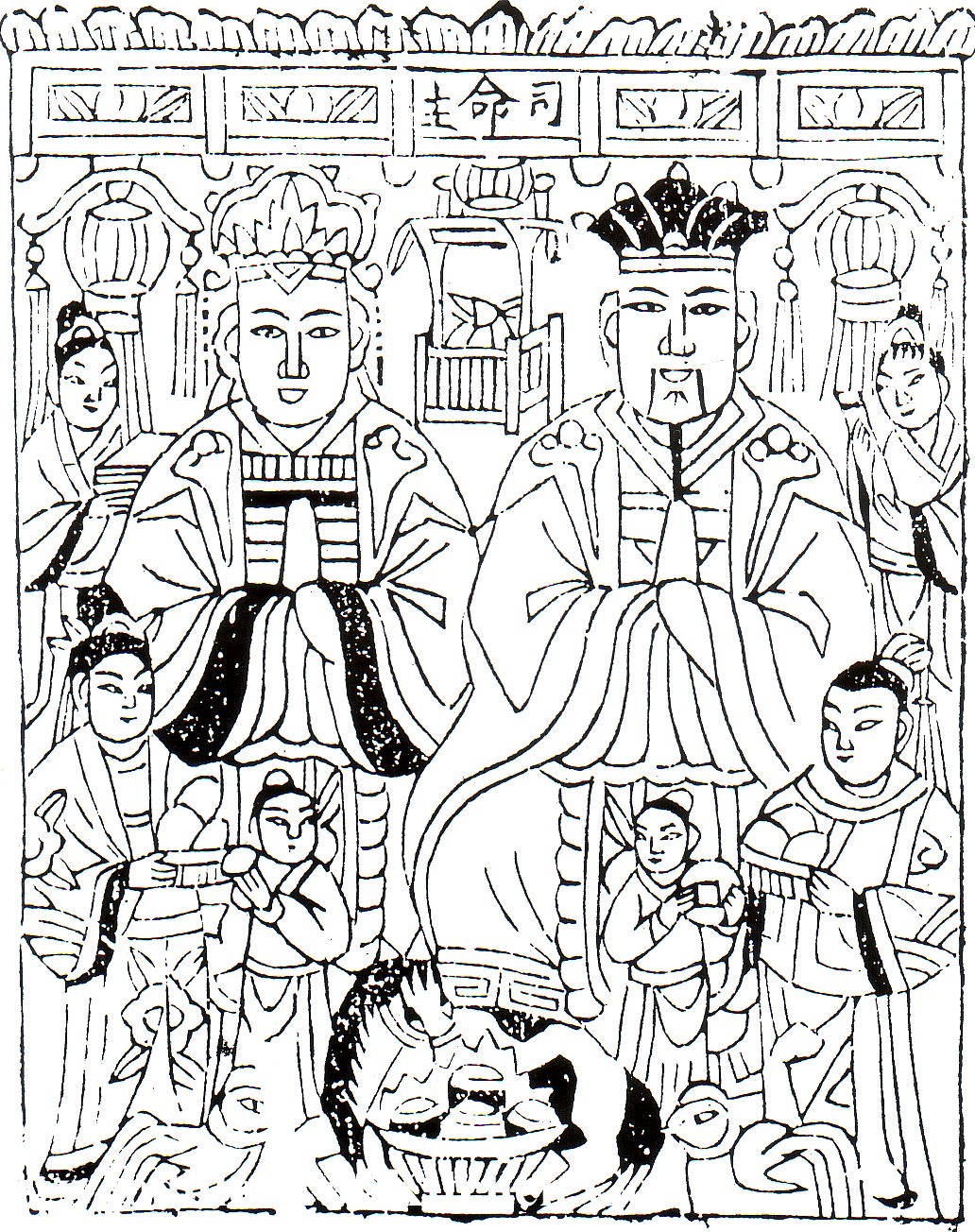 SUE: Years ago the New Year holiday was fifteen days in total. Now, it is really two separate holidays. Chinese New Year is a five thousand-plus-year holiday that for some requires preparation starting a month before New Year's Day. In that month they prepare new clothes and make much food. Currently, only the five days before New Year's Day are used to get ready. Many call these days 'Little New Year.' During them, other than making or purchasing new clothing, food is prepared because during the first five days of the New Year, reheating is OK, cooking is not.
SUE: Years ago the New Year holiday was fifteen days in total. Now, it is really two separate holidays. Chinese New Year is a five thousand-plus-year holiday that for some requires preparation starting a month before New Year's Day. In that month they prepare new clothes and make much food. Currently, only the five days before New Year's Day are used to get ready. Many call these days 'Little New Year.' During them, other than making or purchasing new clothing, food is prepared because during the first five days of the New Year, reheating is OK, cooking is not.
A week or less before the New Year's Day, the picture of the Kitchen God comes down; it is burned. With firecrackers sounding like horses hooves, he is sent on his way to heaven to report on those in whose home he lives. He usually returns New Year's Eve between 9:00 and 11:00 pm, a time called the Hai period. Incense is lit awaiting all spirits to descend to earth. The two hours after that, called the Tsu, offerings are made to the Gods and a new picture of the Kitchen God replaces the one sent heavenward. In some regions, he does not get replaced until New Year's Day. Before the Kitchen God departs, it is customary to pay all debts, clean the house, and tend to similar-type tasks.
When the new Kitchen God is put up, every one of the inhabitants of the home, eldest to youngest, bows before him and pays respects to ancestors and elders; many also ask for peace, prosperity, and good health for family and home. At midnight, a feast ensues, youngsters allowed to stay up for it. Many families eat only vegetarian food, though that tradition is waning. More people want poultry and fish on their New Year's Eve table; these symbolize family unity and prosperity. Gifts can be exchanged, red envelopes with money inside are given to the children, the poor, and to poor relatives when they see them or they come to visit.
The next day, the closest members of the families visit. Those that do, bring a plant, or a food delicacy such as oranges, melon seeds, candied fruits, or New Year cakes. They look at the traditional family 'money tree' and are served spring rolls and similar foods. Most foods served look or sound like money or prosperity The remaining days, other family members and friends visit or do the visiting. The third day is when lion dances begin in the streets; these continue through the fifth day. This day is when everyone might make New Year visits. After this, food can again be cooked and life can return to normal.
Ten days later is Lantern Festival time and the time of a full moon. The day before, that day, and the day after it, lanterns are suspended from doorways, women often wear white, and moon cakes are served and eaten. Many Chinese cities have floats and special events on the evenings of these three days. For the entire New Year holiday, people used to get two weeks off, New Year's Eve through Lantern Festival day, but no more. Nowadays, they get three to five, not fifteen days with no work. This 'Spring Festival,' as the first five days are called in China, is the beginning of a new agricultural year. It is China's most celebrated holiday. The Lantern Festival days are second in importance. When both are past, all New Year festivities cease and life goes back to normal.
From HENRY-JO in LONDON:
What or is it where are Dongjiang dishes?
HENRY-JO: Amazed that no one has ever asked that great question before. One can simply answer, they are Hakka dishes. A more complete response is that the foods from the Guangdong Province or what was called Cantonese cooking is really the three distinct culinary styles of Guangzhou, Chiu Chow, and Dongiang. Dongjiang style is that of the Hakka who inhabit the area. Their flavors are simple, some call them plain. They are refreshing and beautiful, plain in summer and fall, stronger in Fall and Winter. They require fresh and fragrant ingredients, use lots of seafood, and stress the original flavors of all the ingredients.
From ANNE via e-mail:
As a subscriber to Flavor and Fortune for several years, I continue to look forward to every single issue. I do so enjoy the book reviews and articles on various Chinese ingredients. Truthfully, there is not a single feature I do not like. I did enjoy your recent review of Susanna Foo and thought you and your readers might enjoy another 'review' found in my blog. Those who want to learn more about this lady can go to: www.bearcuisine.com Thanks so much for all your hard work in educating Americans about Chinese food and their culture.
ANNE: Thanks to you and many others who compliment and encourage. Have included your blog site so that readers might enjoy it, too.
From BETTE in NORTHPORT:
I have been enjoying your magazine since my son gave me a subscription. The depth of information is fun to read and I am learning so much about the history of the cuisine.
BETTE: Thanks for your kind words. Many tell us they learn lots reading this magazine. We are pleased you and they enjoy and benefit from Flavor and Fortune.
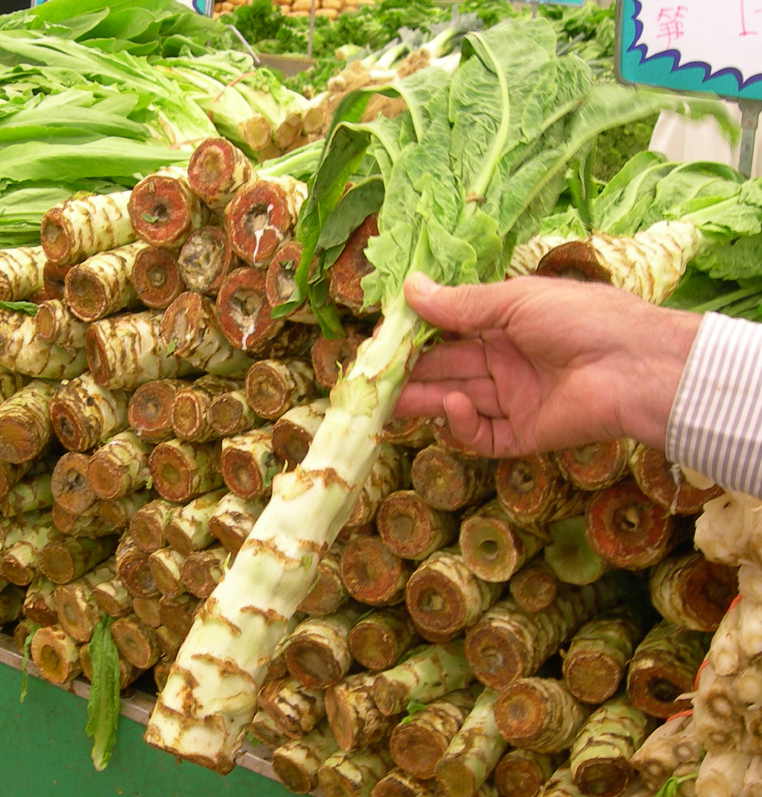 From URSALA in MINNEAPOLIS:
From URSALA in MINNEAPOLIS:
I saw this unusual green in an Asian market in Chicago and learned it was celtuce. When I got home I could not find a way to prepare it in my one hundred Chinese cookbooks. Do you have such a recipe? While searching for a celtuce recipe, I observed this gourd with hairs on it. My cookbooks did not help there, either. Any recipes for that, whatever it is correctly called?
URSALA: As to the celtuce, after much looking, we did find a printed recipe for you. Do you know it is also called stem lettuce, Chinese lettuce, garden lettuce, even asparagus lettuce, so maybe you need to check it out under one of these names. Botanically, this Latuca satvia Angustana, is called wo sun by the Chinese. It is in the Asteraceae family, and one source said it was common in China's north and west. Food Plants of China by Shiuying Hu advises a wide variety are found and used in the Yangzi River region. We know of many recipes for blanching, braising, stir-frying, even pickling or mashing. Several sources say the Chinese love celtuce in soups and casseroles; and we do, too. Before using it, peel the stems. Cook or use peeled stems and leaves in salads. In the United States we have only seen it green or light green. However, once in China, we did see it with a reddish stem and bronze-colored leaves. Shiuying Hu calls the leaves purplish, not red, and indicates that nine cultivars were introduced to Cornell University's experimental gardens prior to 1920; they came from Shanghai. She advises that the seeds are used in Chinese herbal medicine to improve the quality of mother's milk, stimulate hair growth, and enhance kidney ailment recovery.
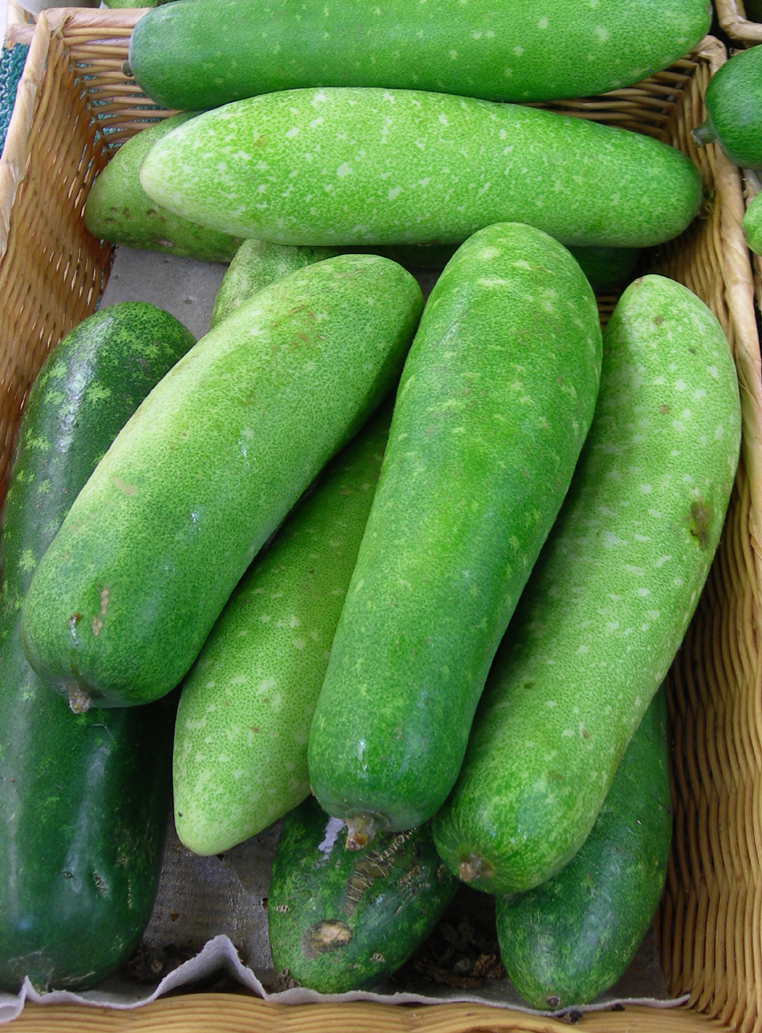 As to the gourd, it is also known as a fuzzy or hairy melon. It loses its baby fuzz, sweetness too, as it ages. It can be found shaped like a bat or more squat. It is at its best when young. Then, most folk simply rub the fuzz off of this mao gua, as the Chinese call it. Related to white gourd and wintermelon, it has lots of relatives. Rarely is it eaten skin on, except when stuffed. Botanically known as Benicasa hispida, this gourd is most often peeled and cut into a plethora of shapes, chef's choice. It goes well with pork and marries well with Chinese black mushrooms. Recipes for both follow.
As to the gourd, it is also known as a fuzzy or hairy melon. It loses its baby fuzz, sweetness too, as it ages. It can be found shaped like a bat or more squat. It is at its best when young. Then, most folk simply rub the fuzz off of this mao gua, as the Chinese call it. Related to white gourd and wintermelon, it has lots of relatives. Rarely is it eaten skin on, except when stuffed. Botanically known as Benicasa hispida, this gourd is most often peeled and cut into a plethora of shapes, chef's choice. It goes well with pork and marries well with Chinese black mushrooms. Recipes for both follow.
From JOE via snail mail:
Might be the only one who appreciated your information about shark's fins. Yes, I do worry about depleting this food source and honorific, but perhaps you could please me, too, if you told me and others where to get artificial sharksfin. A recipes for it would be nice, as well.
JOE: Thanks for enjoying that segment of information, and telling us so; there were quite a few letters singing the opposite tune. The Asian supermarket we most often frequent, occasionally has a product that looks like real strands of shark’s fin. As you can see in the picture of it, it goes by the name of 'Vegetarian Sharksfin.' Photographed for you and others, do note the price we paid for the package. To make the recipe below, twice that amount is needed. At Gold City on Kissena Boulevard in Flushing NY, we paid the whopping price of $8.98 per package. Now we know why restaurants that sell or serve imitation items need to charge close to the same amount as they do for the real thing. It does make the buyer appreciate it more, or does it? This particular brand has no animal gel, though some do.
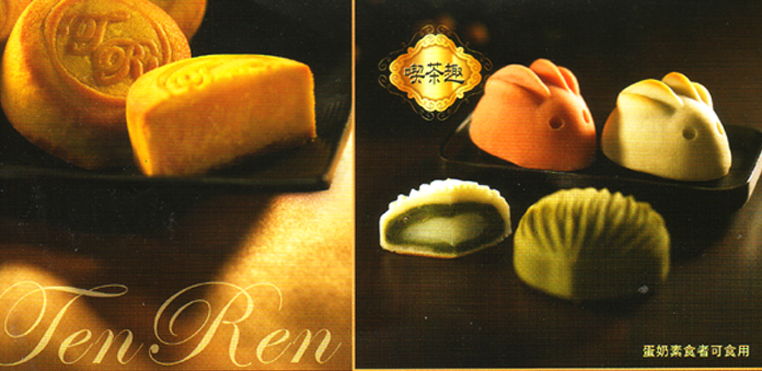 From RISHA in VANCOUVER:
From RISHA in VANCOUVER:
My friend in New York wrote they now can purchase moon cakes in cute designs and with unusual fillings. Have you seen any of these?
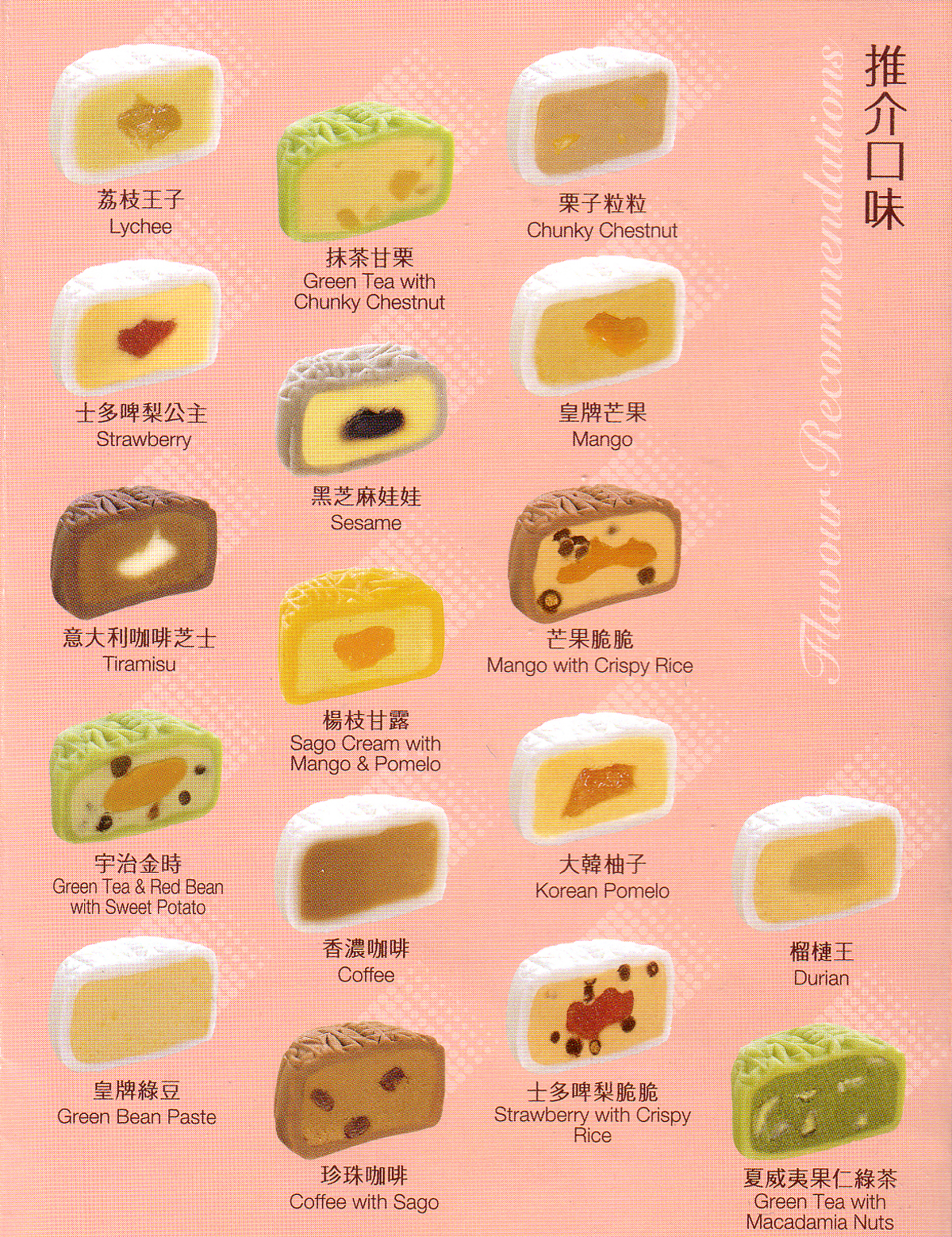 RISHA: We did ask around, had never seen them ourselves, then we received your letter. Now we have not only seen but tasted some. Two vendors provided their advertisements and some tastes. Have fun seeking them out, buying them, and of course, tasting them. The pictures on this page should help in the seeking realm.
RISHA: We did ask around, had never seen them ourselves, then we received your letter. Now we have not only seen but tasted some. Two vendors provided their advertisements and some tastes. Have fun seeking them out, buying them, and of course, tasting them. The pictures on this page should help in the seeking realm.
From MARIANNE via e-mail:
What is Daliang style?
MARIANNE: Daliang is the name of a city. Know of only one dish from there. A recipe for their Lotus Disks follows these letters, as do other requested recipes.
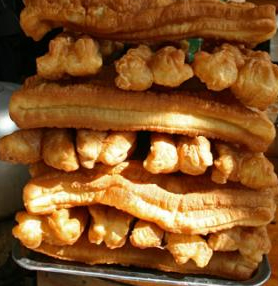 From Harrison via e-mail:
From Harrison via e-mail:
My mom used to make a dish for dinner with long fried rolls she bought, beef, too. Do you have such a recipe; I miss it and her. She passed away last year.
HARRISON: Our condolences, along with a recipe that may resemble hers or be on target. We hope it brings back fond memories of Mom and meals. Incidentally, those rolls are called yau tiao or 'Chinese crullers.' Look for them in Asian bakeries and markets, especially in the mornings.
From JACK via e-mail:
Just saw some very dark Chinese sausage in an Asian market, can you tell what this was and how to cook it? No one there could advise.
JACK: Assume it was either duck or liver sausage, or a mixture of both. Below is a recipe that uses several Chinese sausages.
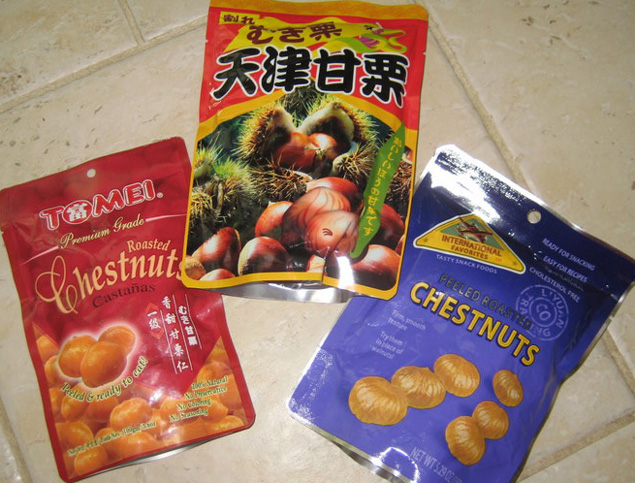 From JUANITA via e-mail:
From JUANITA via e-mail:
Thanks for the article on chestnuts. However, I did not find those multi-layered foil and plastic packages you spoke about in my market. What do they look like?
JUANITA: A picture is worth a thousand words. Here are three of those packages. Show it to someone in your Asian market and we do hope that should help you locate them and save the peeling process.
| Celtuce with Cloud Ears |
|---|
1 pound celtuce (also known as stem lettuce) 1/4 cup dry cloud ear fungi, soaked in warm water for half an hour or until very soft 1 Tablespoon vegetable oil 3 cloves garlic, peeled and minced 3 slices peeled fresh ginger, minced 2 scallions, minced, green and white parts separated 2 Tablespoons rice wine 1 Tablespoon chili bean or black bean sauce 1 Tablespoon thin soy sauce 1 Tablespoon dark soy sauce 1 Tablespoon mushroom soy 1 teaspoon sugar 1 teaspoon freshly ground Sichuan peppercorns Preparation: 1. Separate leaves and stem from celtuce. Peel the stem then cut them into two-inch matchstick size pieces. 2. Cut cloud ear fungi into thin strips the thickness of the celtuce stems. 3. Heat wok or fry pan, add oil, and then stir-fry garlic and ginger for one minute before adding the rice wine, chili bean sauce, and all three soy sauces, the match stick pieces of the celtuce and the cloud ear fungi. Stir them for one more minute. 4. Add sugar, celtuce leaves, and the Sichuan peppercorns. Toss the entire mixture three or four times, then serve. |
| Hairy Melon with Pork |
|---|
1 pound hairy melon, peeled and cut angle-shaped 1 Tablespoon vegetable oil 1/4 pound fatty pound pork, minced 1 teaspoon thin soy sauce 1 teaspoon oyster sauce 1 teaspoon sugar 6 slices fresh ginger, peeled and slivered 1 conpoy (dried scallop) soaked for an hour, then shredded 2 Tablespoons Chinese rice wine 1 cup chicken stock 1 teaspoon sesame oil 1/4 teaspoon chili paste 2 Tablespoons cornstarch mixed with same amount of cold water Preparation: 1. Toss the hairy melon cubes with the vegetable oil. 2. Heat a wok or large fry pan, add the pieces of hairy melon and toss until they brown on the edges, about three minutes, then remove to a plate. 3. Mix pork, soy and oyster sauces, and the sugar and let rest about fifteen minutes. 4. Reheat the wok or fry pan, and add the pork mixture stir-frying it. Add the ginger, scallop shreds and the rice wine, and continue to stir-fry for another minute or two before returning the hairy melon pieces to the wok. 5. When the contents in the wok or fry pan are very hot, add the cornstarch mixture and stir until thickened. Serve. |
| Lotus Root Disks |
|---|
1/2 pound lean pork, hand minced 1 section of a fresh lotus root 5 water chestnuts, minced 1 large Chinese black mushroom, soaked, stem discarded, then minced 1 egg white (optional) 1 teaspoon chicken or vegetable boullion powder 1 teaspoon sugar 1 Tablespoon water chestnut powder 2 Tablespoons cornstarch 3 Tablespoons vegetable oil 1 large leaf of lettuce, for lining a serving plate. Preparation: 1. Mix all the ingredients except the vegetable oil, and make these into two-inch balls. Then flatten them gently. 2. Heat a large fry pan, then add the oil and when heated to medium (not hot), place the flattened disks in it and fry them until golden, turn over and fry them on the other side. Then remove them one by one to paper towels, and then to a serving plate with the lettuce leaf on it, and serve. |
| Beef with Yao Tiao |
|---|
1/2 pound lean flank steak, cut into thin slices, each cut in half crosswise 1 Tablespoon oyster sauce 2 Tablespoons Shaoxing yellow rice wine 1 Tablespoon dark or mushroom soy sauce 2 Tablespoons cornstarch 2 Tablespoons vegetable oil 2 yau tiao, sliced into rounds 1 red chili, seeds removed, and minced 6 whole canned water chestnuts, sliced into rounds Preparation: 1. Mix the meat with the oyster sauce, rice wine, and the soy sauce and allow to rest fifteen minutes, then stir in the cornstarch. 2. Heat a wok or fry pan, add the oil and fry the slices of yautiao, then remove them and drain on paper towels. 3. In the remaining oil, drain then stir-fry the beef and the chili pepper until the meat is no longer pink, then add the water chestnut and the remaining meat marinade. Stir until it starts to thicken, then add the yau tiao slices, toss, and serve. |
| Many Sausage Sticky Rice |
|---|
1 cup sticky rice, soaked overnight, then drained 1 Chinese duck or liver sausage (or one of each) 1 regular Chinese pork sausage 1 teaspoon dried small shrimp, soaked for half an hour 1 Tablespoon vegetable oil 2 shallots, minced 1 Chinese black mushroom, soaked, stem discarded, and minced 2 Tablespoons oyster sauce 1 teaspoon thin soy sauce 1 teaspoon chicken bullion powder Preparation: 1. Drain sticky rice and steam it for fifty minutes. 2. Steam the sausages, then mince them and mix with the sticky rice. 3. Heat a wok or a large fry pan, add the oil, and stir-fry the sausage meats for two minutes, then add the shrimp and the minced shallot, and stir fry another minute before adding the minced black mushrooms. Stir-fry another minute, then add the oyster and soy sauces and the bullion powder and stir for one minute before transferring to a large bowl; then serve. |

Copyright © 1994-2025 by ISACC, all rights reserved
Address
3 Jefferson Ferry Drive
S. Setauket NY 11720